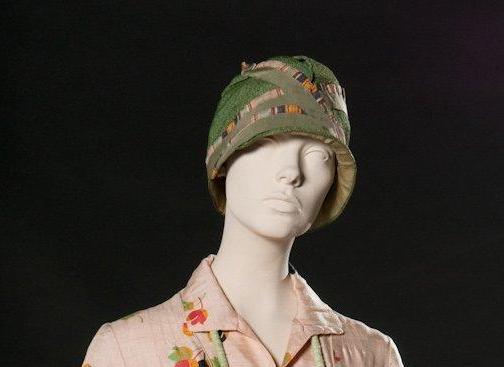1920s cloche
Some of you are probably wondering why we didn't discuss the close-fitting cloche hat featured in our most recent post,
 Cloche c. 1925 Gift of the Oregon Shakespeare Festival 91.789.3
Cloche c. 1925 Gift of the Oregon Shakespeare Festival 91.789.3
Cloches were worn throughout the year, by all ages. In winter, a wool cloche, when worn with a coordinating wool jacket, would keep out the cold. For the warmer months, a cloche made of woven real or synthetic straw was just the thing. No matter what the season, fashion commentators consistently mentioned a diversity of colors and trims. The basic shape of the cloche varied slightly throughout the decade, from a strict, minimal bell around 1924 to a softer, slightly draped silhouette towards the end of the decade.
So as not to distract from its distinctive silhouette, cloche trimmings were minimal and usually conformed to the shape of the hat. Some women embellished their cloches with a three-dimensional ornament such as a small flower or jeweled clip placed at the front or side of the hat. The FIDM Museum cloche seen here utilizes coordinating ribbon, placed in a geometric formation at the center front. In the spring of 1925, the New York Times featured a similar cloche, described as "a demure little hat...composed of fine straw and satin ribbon joined in strips to form a diagonal pattern over the crown."2
Given its tight fit, the cloche could only be worn over the newest hairstyle: the bob. Originally a short, ear or chin length blunt cut, the bob soon expanded into numerous variations, many of which were named. Ranging from the fanciful (orchid, coconut, and French swirl) to the self-explanatory (the lightly waved marcel bob) these names indicated the way in which the bob thoroughly invaded popular culture. With its sleek silhouette, the bob served as the ideal accent for the streamlined styles of the 1920s and the perfect hairstyle for a cloche. In 1926, it was declared that "hats have never before been designed with such precise relation to the coiffure."3 Because respectable women were expected to wear their hair long and uncut, the bob was extremely controversial. Hairstylists feared it would put them out of business, doctors warned that an exposed neck could lead to serious illness and religious leaders considered it immoral. All of this fuss wasn't really about the newest hairstyle. Rather, the bob served as a flash point for anxieties regarding the changing role of women during the 1920s. Despite the immense controversy over bobbed hair, the popularity of the bob gradually allowed shorter hairstyles to enter the realm of fashion.
1 "Small Shapes Favored Again." New York Times 27 Nov. 1927: X16. 2 "Artistic Hats Shown." New York Times 1 Mar. 1925: X10. 3 "Cloche Hat Will Prevail This Spring." New York Times 7 Feb. 1926: X11.
